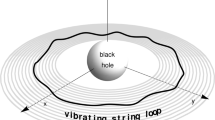Abstract
Beginning with the stress-energy tensor of an elastic string this paper derives a relativistic string and its form in a parallel transported Fermi frame including its reduction to a Cosserat string in the Newtonian limit. In a Fermi frame gravitational curvature is seen to induce three dominant relative acceleration terms dependent on: position, velocity and position, strain and position, respectively. An example of a string arranged in an axially flowing ring (a lasso) is shown to have a set of natural frequencies that can be parametrically excited by a monochromatic plane gravitational wave. The lasso also exhibits, in common with spinning particles, oscillations about geodesic motion in proportion to spin magnitude and wave amplitude when the spin axis lies in the gravitational wave front.
Similar content being viewed by others
References
Misner, C.W., Thorne, K., Wheeler, A.: Gravitation. Freeman, San Fransisco (1973)
Finn L.S.: Gravitational sources for acoustic detectors. http://xxx.lanl.gov/abs/gr-qc/9609027. In: Proceedings of the OMNI-1. The First International Workshop for an Omnidirectional Gravitational-Wave Observatory.
Tucker, R.W., Wang, C.: Dark matter interaction. Class. Quantum. Gravity 15, 933–954 (1998)
Antman, S.: Non-Linear Problems in Elasticity.Applied Mathematical Sciences, 107. Springer, Berlin Heidelberg New York (1991)
Tucker, R.W., Wang, C.: J. Sound Vibration 224(1), 123–165 (1999)
Benn, I.M., Tucker, R.W.: An Introduction to Spinors and Geometry with Applications in Physics. Adam Hilger, Bristol (1987)
Nesterov, A.: Class. Quantum Gravity 16(2), 465–477 (1999)
Dixon, W.G.: Dynamic of extended bodies in general relativity. Proc. Roy. Soc. Lond. A 314, 499–527 (1969)
Mohseni, M., Tucker, R.W., Wang, C.: Class. Quantum Gravity 18, 1–11 (2001)
Ciufolini, I., Wheeler, A.: Gravitation and Inertia. Princeton Series in Physics. In: Treiman (ed.): Princeton University Press. Princeton, New Jersey 08540 (1995)
Healey, T.: Q. Appl. Math. 48 679–698 (1990)
Sachs, R.K., Wu, H.: General Relativity for Mathematicians. Springer Berlin Heidelberg New York (1997)
Author information
Authors and Affiliations
Corresponding author
Rights and permissions
About this article
Cite this article
Bollada, P.C. How to lasso a plane gravitational wave. Gen Relativ Gravit 37, 343–363 (2005). https://doi.org/10.1007/s10714-005-0023-1
Received:
Issue Date:
DOI: https://doi.org/10.1007/s10714-005-0023-1




